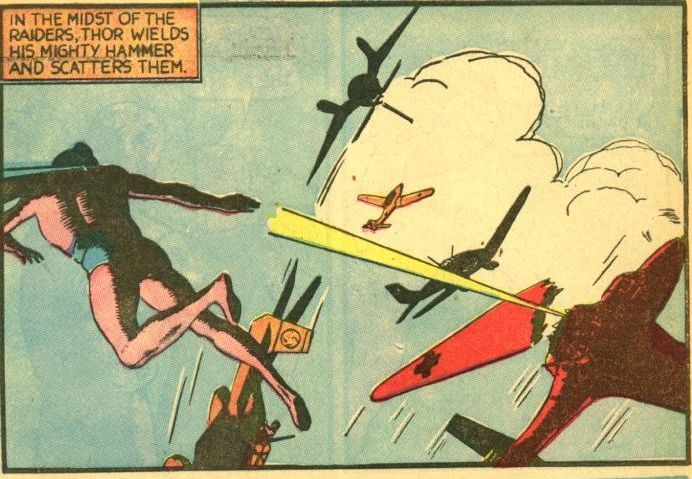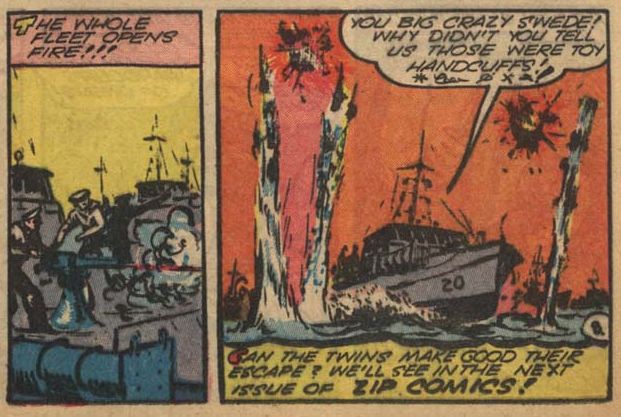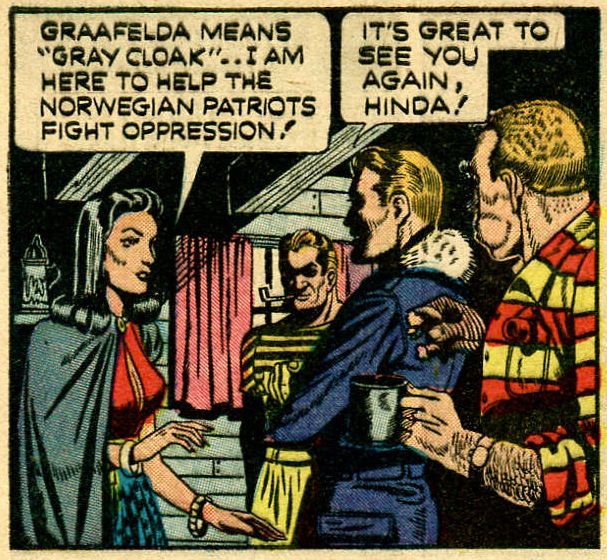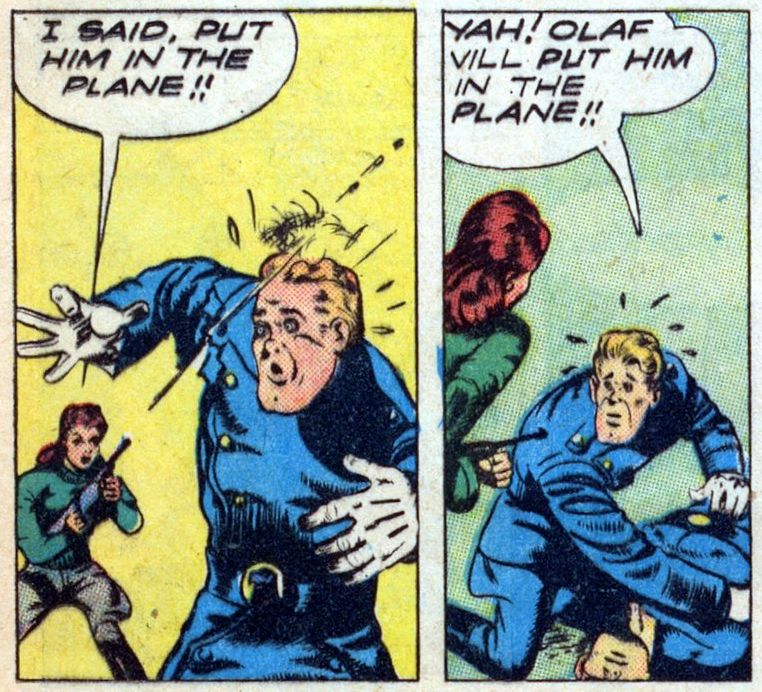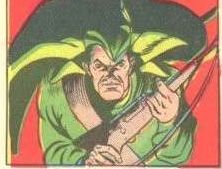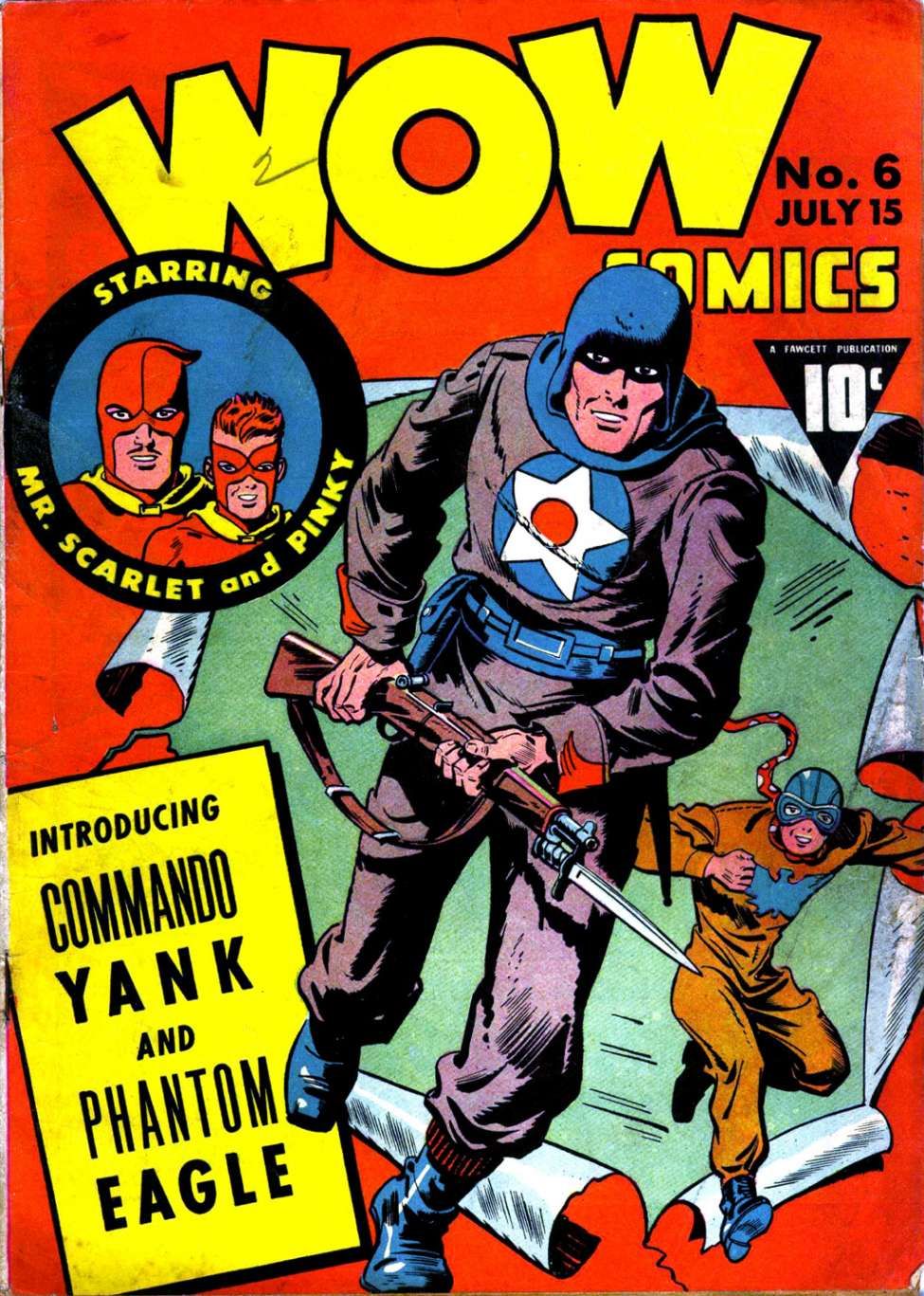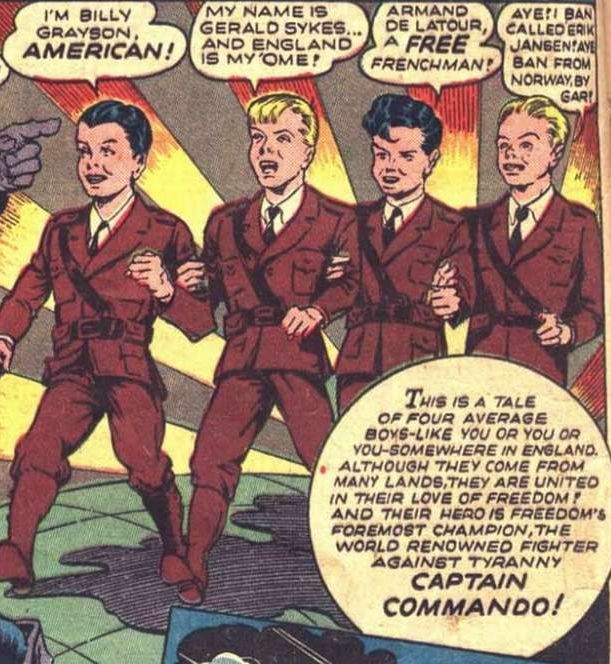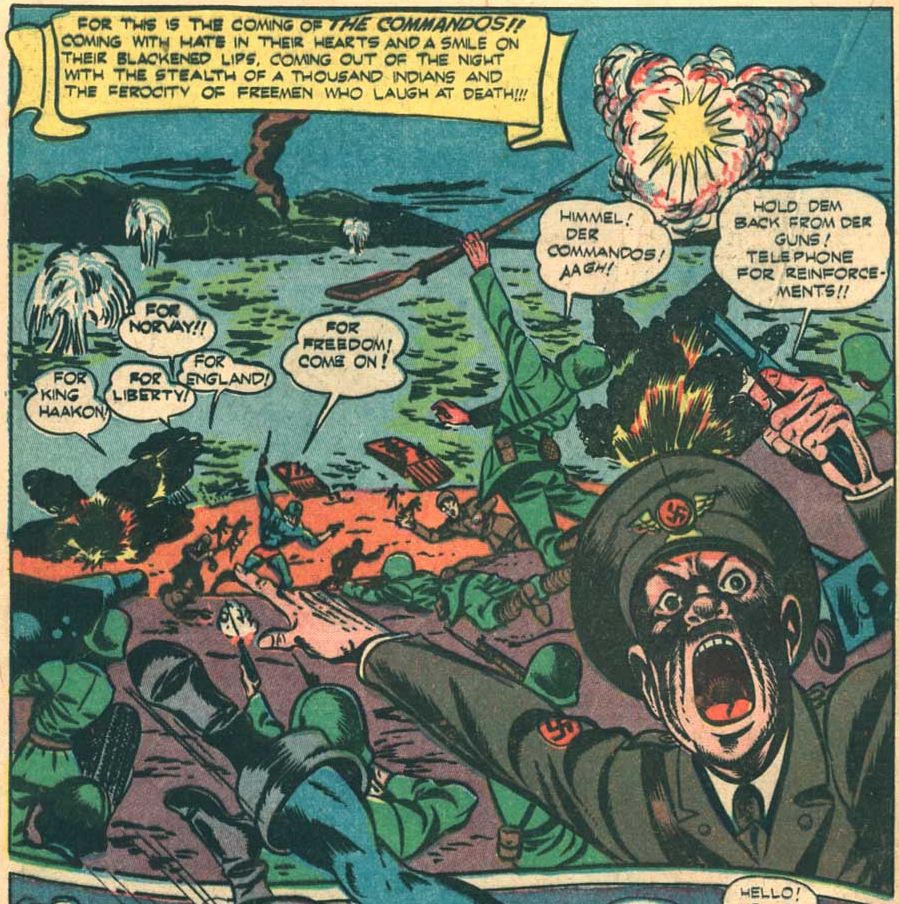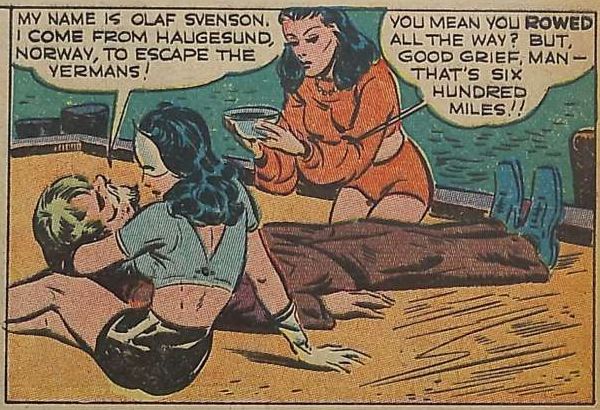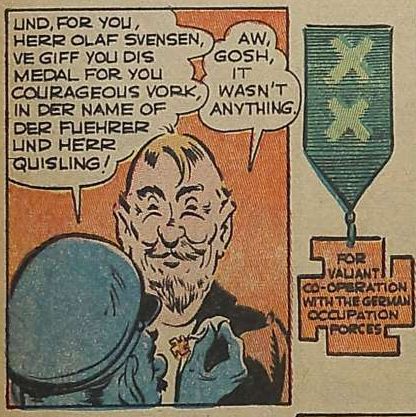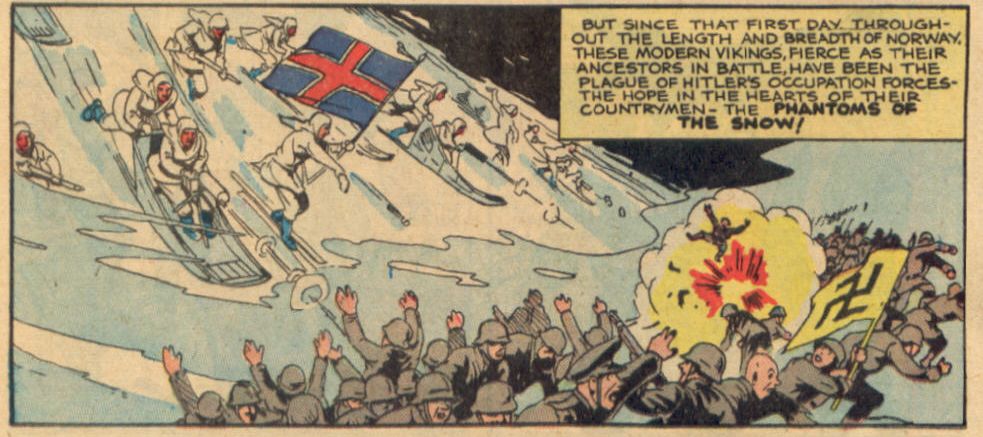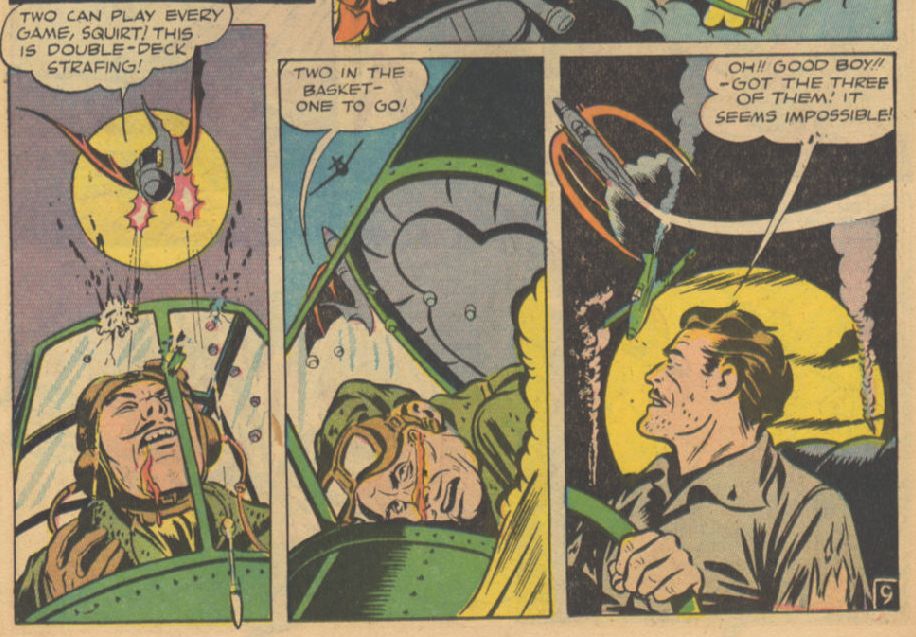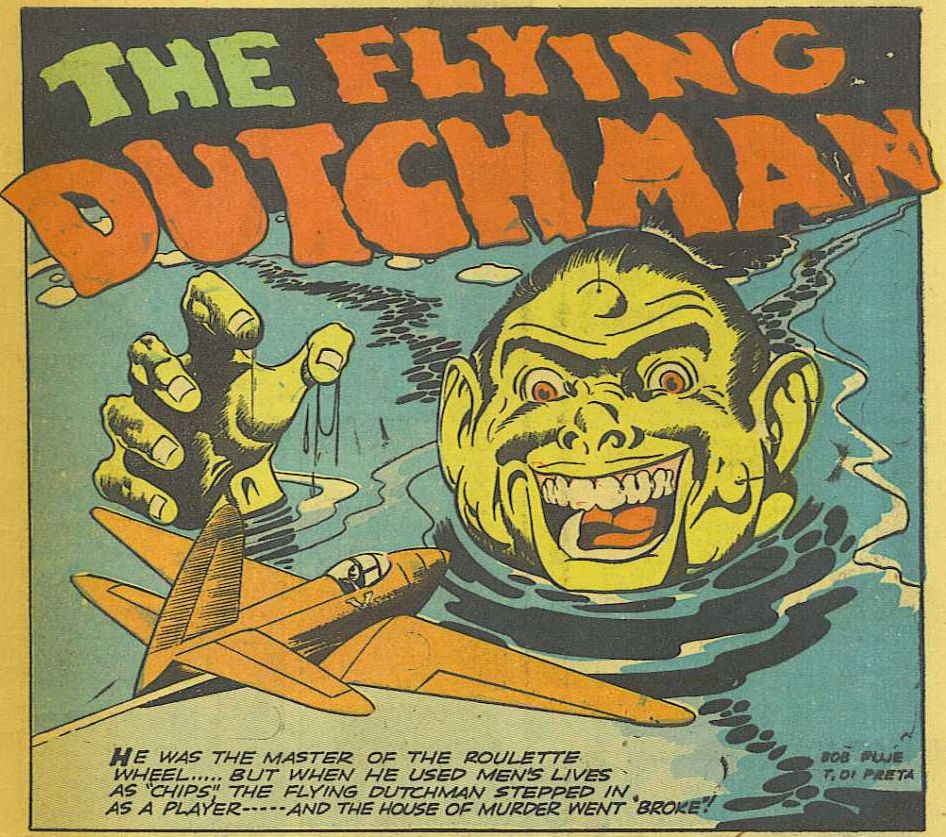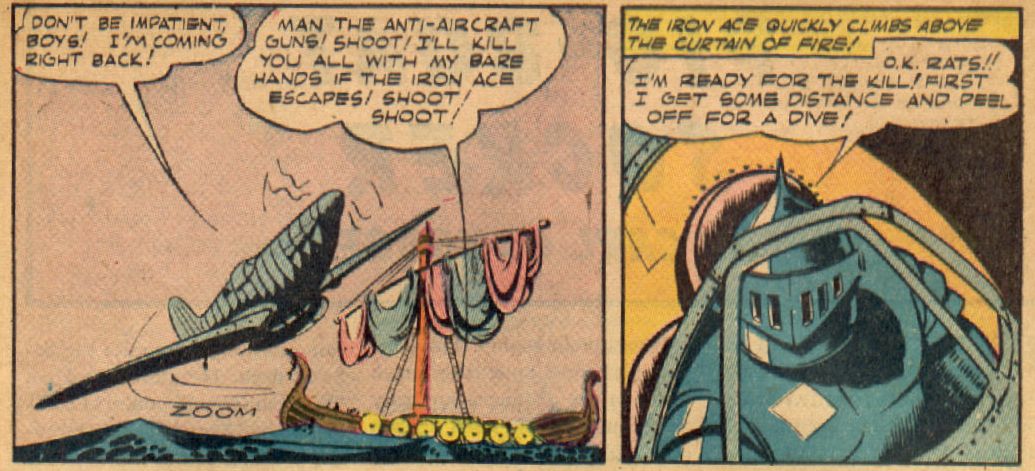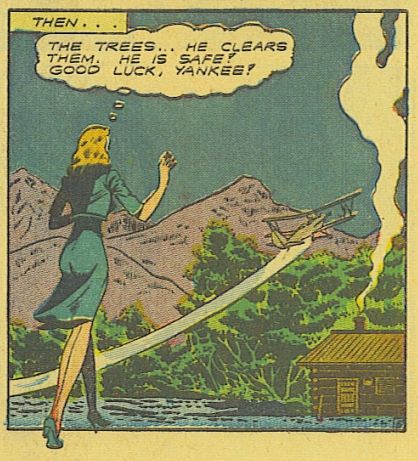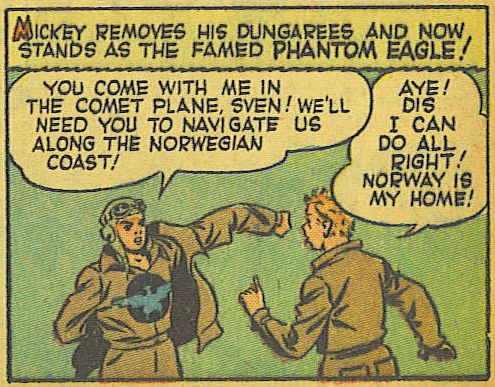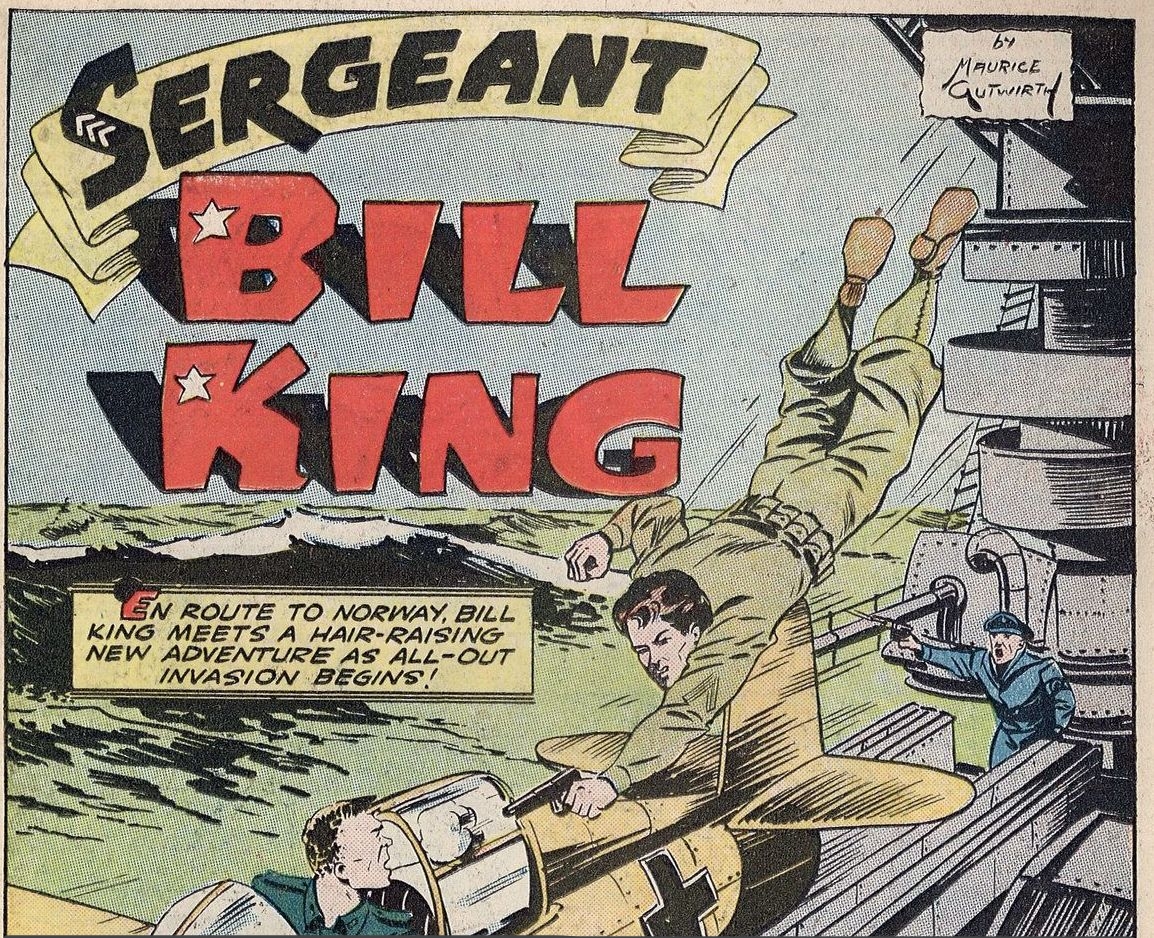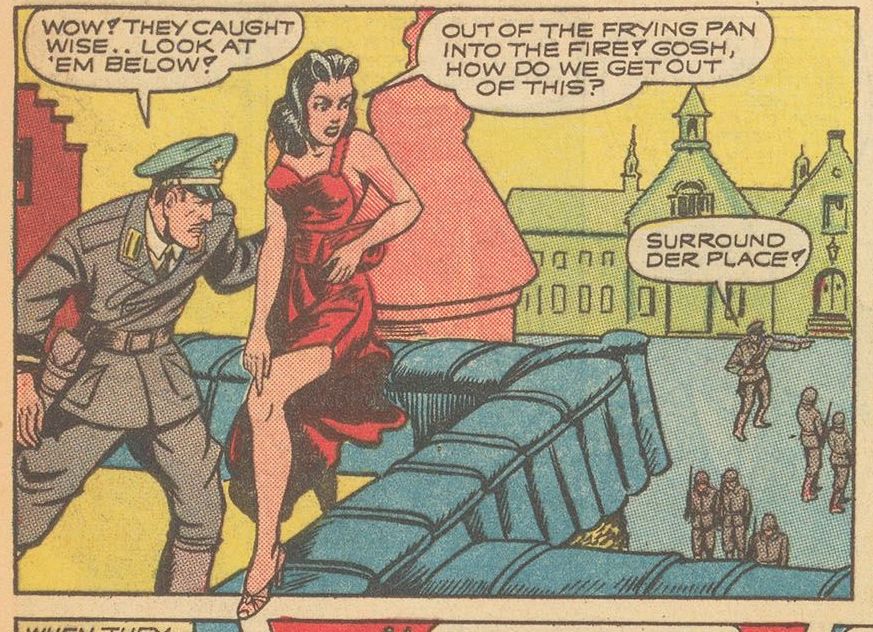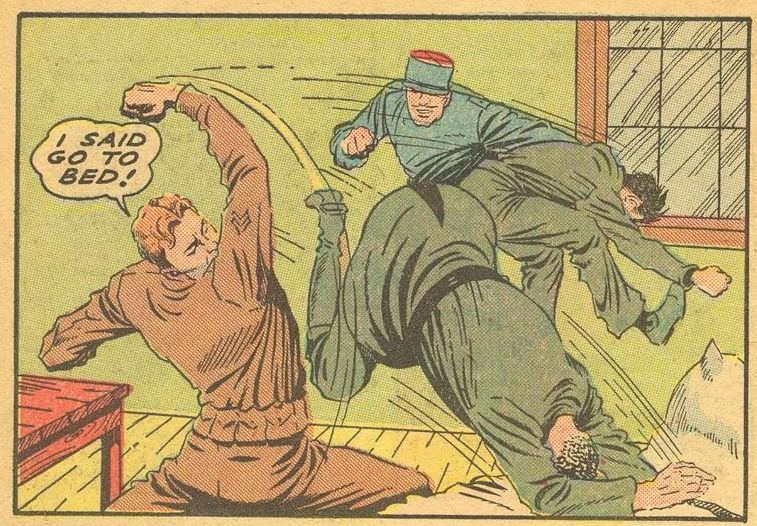Look to Norway
On 16 September 1942 President Franklin D. Roosevelt gave a speech at the Washington Navy Yard. World War II had raged for nearly three years, and even though no one present could know, almost three more years of bloodshed and struggle remained.
"If there is anyone who still wonders why this war is being fought," Roosevelt said, "let him look to Norway. If there is anyone who has any delusions that this war could have been averted, let him look to Norway; and if there is anyone who doubts the democratic will to win, again I say, let him look to Norway."
In other words, the US president argued that the present war was a necessary and unavoidable one, and that in the end democracy would prevail over fascism. And he used Norway as an illustration: A small and peaceful democracy that had fallen victim to Nazi aggression, but which now fought back with a domestic resistance movement as well as free Norwegian military forces being trained in Allied countries.
Roosevelt's speech is said to have had an impact on the American public's opinion on the struggle in Europe, especially regarding Norway, whose reputation had taken a hit from Norwegian Nazis' collaboration with the German occupiers.
How much impact did the speech have? It would have been difficult to say back then and even more difficult now, almost eighty years later. How do you measure public opinion? By opinion polls, of course. But lacking those, the best way is probably by taking a look at how public opinion manifests itself in popular culture. However, in order to reduce this gargantuan task to a somewhat manageable size, I will let comic books represent all of popular culture. Why comic books? In 1977 author Michael Uslan stated: "From the 1930s through today comic books have expressed the trends, conventions, and concerns of American life. Comics have been a showcase for national views, slang, morals, customs, traditions, racial attitudes, fads, heroes of the day, and everything else that make up our lifestyles."
If Michael Uslan is right — and there's no reason to doubt him — comic books are a true mirror of the times. Or at least they were before electronic entertainment eclipsed all other media in recent times. During the war years, comic books were so much in demand that their huge print runs contributed to a paper shortage, forcing publishers to reduce the number of pages in each issue.
World War II in Comic Books
So, do comic books indicate that Norway served as an inspiration for the American people during the Second World War? When perusing comics from 1940 and 1941, the first thing striking the reader is that the war was rather late in coming to the comic pages. At this stage comic books still featured mostly daring detectives and dastardly criminals of every stripe. Besides cowboys, of course, and handsome adventurers roaming the world's jungles and outer space. And superheroes seemed to busy themselves fighting domestic crime, preferably crime committed by costumed criminals.
One of the first comic book characters to take an active interest in the war — or rather the coming war — was Corporal Collins, an American stranded in Paris, who joined the French army at the outbreak. Collins is blond or red-haired and definitely broad-shouldered, a veritable one-man army. In one panel, he is described as a "two-fisted American", implying that he is strong, virile, and straightforward. He is also very modest and refuses promotion (although he does accept the French Croix de Guerre medal).
War Comics appeared on the newsstands in early 1940, and it was the first comic book entirely devoted to war stories. One of these was called Blockade, and featured Tim and Jerry, two obviously wealthy American youths touring Europe. Told by the American consul in Sweden to return home because war has broken out, they board an old Norwegian freighter for passage to America. The ship prominently displays the name "Norge" (Norway) as well as this nation's red, white, and blue flag. According to the story, Norway is a neutral country. Now, comic books are not the same as newspapers. For one thing, comics cannot compete with the papers' daily updates; from idea to finished artwork, to printed copies, to appearing on newsstands, several months may have passed. When this issue was published in July, 1940, Norway had been at war for three months. But the colors of the flag are fairly accurate, which is not always the case in wartime US comic books.
The same comic book also presents the first Norwegian in our sample. He is a mate on the unnamed freighter and when a German war ship appears, he comments: "German raider stop us. Ay tank dey search us, maybe." Not a very intelligent thing to say, and uttered with an accent indicating he is an uneducated Norwegian-born man living somewhere in the American Midwest, according to the immigrant stereotype of the day.
Events were moving too fast for a slow medium like comics in 1940. By April, Denmark and Norway were overrun by the victorious Germans, but before writers and artists could react, France fell too. Come summer, heroic England fought alone against the Nazi juggernaut, or so the popular media insisted. In reality, England stood with Wales, Scotland, Ireland, the British Commonwealth, and the whole British Empire. In addition, England received moral support from America, as well as increasing amounts of military supplies. But the odds were still uneven.
This "England alone" situation provided a new setting for comic books. From now on, we encounter a steady stream of two-fisted, young, adventurous Americans aiding the plucky British. Most of these fighters join the R.A.F. and reinvent themselves with new and macabre names, like The Skull Squad, The Devil's Flying Twins, and Suicide Smith, Blitzkrieg Buster. And like Corporal Collins, they are all the best of the best. Undisciplined and wild, true, but incomparable (and modest) warriors, teaching the one-fisted Brits how to win.
The Skull Squad consisted of the crew of a Handley Page bomber: a Brit, a Scot, and Jimmy Jones, trigger-happy gunner from America. Their first mission, as described in Wings Comics #1 (September 1940) took the squad to "the high mountains and deep fjords of Norway," where they bombed a few oil tanks, before sinking a German submarine on their way home. No Norwegians appeared in the story, however. Despite "the high mountains and deep fjords", this could have been a bombing mission to almost anywhere in German-controlled Europe.
Meanwhile, America's Super Agent X-5 actually traveled to Norway, or at least to a country called Northland, situated west of the neighboring countries Southland and Finway. But from the accompanying map, there can be little doubt that these countries are really Norway, Sweden, and Finland. And when the American agent goes to the city of Tradheim in the middle of Northland, one have to wonder why the scriptwriter bothered about inventing these obviously phony names.
The scriptwriter, by the way, is Will Eisner, generally acknowledged as one of the greatest comic book creators ever. But even great artists do not produce gold always, and at their worst, Eisner's stories are confusing to the point of being almost unreadable. Unfortunately, our story belongs to the last category. As far as I'm able to tell, the American Super Agent X-5 is sent to Tradheim/Trondheim to find out why this small town imports enough beef to feed a city the size of London. It turns out that a German agent in the town is smuggling weapons hidden in slabs of meat in order to overthrow the government of Northland/Norway. By the time this story was published, Norway was already occupied by Germany — without the aid of smuggled beef. In any case, just like the Skull Squad story, Norway is just a backdrop. The action could have taken place anywhere, anytime. But really, smuggling weapons hidden in slabs of meat? In war food becomes a weapon in itself, tightly controlled by rationing. Smuggling weapons in food is much the same as smuggling weapons in weapons. I wonder if this script wasn't originally conceived as a gangster story taking place at a waterfront warehouse in Eisner's New York, and later tweaked to more or less fit wartime Europe.
The war in Europe provided America's comic book artists with many challenges, however. For one, what did war look like in 1940? America's memories of war dated back to 1918, and at first warriors like Corporal Collins fought the Germans in trenches behind barbed wire, just like Word War I. Another problem was that comic book heroes had become just too powerful. Take for example Thor, superhero and Norse god, who in the summer of 1940 annihilated the Luftwaffe, collected all the war machinery of the Third Reich and dropped it over Berlin, leveling the city and forcing the Germans to sue for peace. However, as every reader knew, the war did not end in the summer of 1940, and Thor's street cred took a hit. Learning a lesson from Thor's awkward victory, Superman's creators made sure their character failed his medical exam when drafted into the army — failed by his eye sight being too sharp, to be sure, but failed he did and because of that never had to serve.
By the summer of 1941, we finally get to see Norway and Norwegians up close, thanks to The Devil's Flying Twins in Zip Comics #15. The twins are Tim and Tom Shane, young, rich American polo players, who have joined the R.A.F., where they distinguish themselves as expert pilots. In fact, they are so resourceful and brave, that the R.A.F. turns to these American youngsters instead of regular British pilots whenever faced with a difficult mission.
In this particular story, the twins are sent to Norway to retrieve the plans for a new explosive. The Norwegian scientist who invented it, hid the plans under the seat of a car of a certain make before he died. Where the car in question is, nobody knows. Searching the whole Nazi-occupied country for one single car with some papers under the seat does not sound like the right kind of mission for a couple of pilots, however good they might be at playing polo. Still the twins accept, since they somehow know that "autos are scarce up there."
Having flown to Norway, the twins hook up with a local man by the name of Swen working for the British intelligence. Swen is big, blond, and stupid. He introduces himself in this way: "Jah - aye bane Swen Olsen." Without question, Swen grew up in the same small town in the rural Midwest as the mate in the Blockade story.
The twins meet two more Norwegians, a couple of elderly ladies called the Primrose sisters. This pair of umbrella-wielding furies shows their fierce spirit by chasing Swen up a tree. Not only does Swen Olsen talk like a stereotypical uneducated immigrant and act like a stupid oaf, he is also a coward. Why the Brits decided to employ such a sorry creature as their agent is an unexplained mystery. But Ed Smalle, the artist, must have felt otherwise, because, despite all of this, the twins brought Swen back to England and made him a regular member of their team.
What happened to the secret plans? The twins found them, of course. They were hidden under the seat of the very car they happened to drive. The new explosive turned out to be a dud, however, inferior even to fire crackers, the R.A.F. concludes. So 0 points to British intelligence, Norwegians, and Norwegian science, and 1 point to wealthy American polo playing pilots.
In Zip Comics #16 and Zip Comics #17 the twins, now with clumsy and inept Swen as their rear gunner, are shot down (what else to expect?). They crash in Denmark, where they meet a woman with the somewhat unusual Danish name of Gretta, who is in the process of making borscht. If the woman's name is curious, the choice of dish seems even more so, since Eastern European borscht never was part of Scandinavian cuisine. Moreover, the twins can reveal the hitherto unknown fact that this particular dish has been banned by the Nazis, leading them to conclude that Gretta must be pro-British. Anyway, Gretta's borscht is described as horrible tasting, but one can hardly expect anything else, as she is just a female Swen, in intelligence, as well as looks.
Through the story, the twins address Gretta as "Fräulein". Why they would speak German in Denmark is unexplained, but it might just be that they knew they needed a foreign language, and German was the only one they had. Gretta disappears before the storyline can be concluded, however, and an even bigger surprise comes toward the end when it is revealed that Swen is not Norwegian at all. "You big crazy Swede!" the twins exclaim, thereby changing Swen's nationality. To Norwegian readers this might come as a relief, but at the same time, it reduces the number of Norwegians we have met so far by 25 percent. After more than a year's worth of war we can only count three — the dull-witted mate of the old freighter and the two feisty Primrose sisters.
Fortunately (or unfortunately), another Swen had already appeared in the comics book pages. This one is Sven (spelled with a v) Knutsen. He burst into a feature called "Powder" Burns, loudly and totally without manners. Like Swen, he is big, blonde, strong, and with limited intelligence: "Let me intorduce me ... Sven Knutsen! I am vun terrible man! Avrybuddy knows det!! Dun't you?"
"Powder" Burns, who is a young American "air adventurer", joins forces with Sven and the archaeologist Cosmo Dust, and like the two American boys in Blockade, they try to escape the war in Europe and reach the United States, but instead end up in a long series of adventures.
However, by issue #4 of Wings Comics Sven goes from being a "Scandinavian" to a "mighty Swede", which brings the number of Norwegians back to three again.
Finally, in Wings Comics #12 from August 1941 we find a story from Norway with elements that will return time and again during the rest of the war — local resistance fighters, sabotage, agents, beautiful women, and American heroes. This particular group of underground saboteurs is led by a woman, albeit not Norwegian. Her name is Hinda Graycloak, a British agent. As Swen is now in Britain someone had to take his place, and this time the Brits wisely picked one of their own.
Actually this story is not about Swen and our polo twins at all, but the above-mentioned Suicide Smith, Blitzkrieg Buster. After crashing his Hurricane fighter in Norway, Smith encounters Hinda Graycloak and her band of saboteurs. Smith, who knows Hinda from before, is surprised to learn she is addressed as "Graafelda", until he is informed that this is merely the Norwegian translation of her family name. Which, of course, it isn't. After helping Graafelda's group destroy an ammunition train outside Narvik, Smith averts a sneaky air attack on England from a secret German base nearby. And rounding off the day's work, he destroys a German warship.
Whoever wrote this story did not have a strong grasp on geography. It would have been impossible for Suicide's Hurricane fighter plane to reach Narvik, and likewise totally impractical for Germans to use this area as a base for aerial attacks on England. Another curiosity is that Norwegian farms look much like American farms in the Midwest, and at least one sports a Dutch style windmill.
Be that as it may, of greater importance to the current inquiry is the portrayal of the Norwegians. They are resistance fighters, all right, and don't say much. As they smoke their pipes and dunk their doughnuts (now where did they get white flour, coffee and tobacco from?), they talk normally without Swen and Sven's Midwestern accent. However, there is no question that they strictly belong to the supporting cast. The heroes are Graafelda and the American Suicide Smith — especially two-fisted Smith, since the story ends with Graafelda having to be rescued by him.
Another American daredevil flying for the R.A.F. was Ted O'Neil. His team mate was British, a cockney by the name of Hinky, who functioned mainly as comic relief and as a means to get O'Neil into trouble. In a way he is Swen, but without Swen's muscle strength and boundless stupidity. In the August 1941 issue of Prize Comics O'Neil and Hinky aid the Royal Navy in destroying oils tanks on "the main island of a strategically important group in the Arctic Ocean." This nameless, but important, island is occupied by German soldiers who oppress and harass the islanders and plan to use the stored oil for their war effort.
In many ways, the story is as illogical as the Eisner story from Tradheim. For one thing, midway in the story the islanders suddenly become Norwegians, indicating that the "island" has been Norway all along. And as the story ends, the Norwegians are free because the Royal Navy bombarded the oil tanks and killed the Germans. Free? Free to be killed in German reprisals for the raid, maybe. At least we see people suffering under Nazi occupation, and one black bearded and somewhat scary-looking Norwegian plays a minor part, as he helps the heroes escape from German imprisonment. Besides, he knows where the oil tanks are. Right behind the raffinery. Imagine that.
These tall tales about maverick American pilots quickly became standardized — heroic hero and comical sidekick beat Germany with a little aid from their friends in the resistance. One feature that departed from this mold was Blackhawk, one of most popular and longest-running flier comics of the war.
Blackhawk, too, was created by Will Eisner, and made his first appearance in Military Comics #1 from 1941. How was Blackhawk different? For one thing, he hailed from neither America nor Britain (although this changed later in the series). On the contrary, he was a Polish fighter pilot who wanted revenge for what Nazi Germany did to his country and his family early on in the war. Consequently, Blackhawk designed his own fighter airplane, and from his secret island in the Atlantic, assembled a team of crack pilots, who like himself had escaped from a country occupied by the Nazis. Operating under the name of the Blackhawks, we find two more Poles, Stanislaus and Zeg; Andre from France; Hendrickson from the Netherlands; the Russian Boris; Olaf from Norway; and Chuck from Texas. Texas? Neither German-occupied nor a country, but I guess any team of heroes those days had to include at least one American. In addition, Blackhawk hired a Chinese called Chop-Chop. Like Texas, China was not under German control, but the team needed a cook as well as comic relief. But what about Olaf? Well, he is big and strong, a human juggernaut. But unfortunately, his mental capacity does not match his muscular strength, and he comes across as simple-minded. He also talks funny, for instance preferring to use his first name instead of "I" — a habit which often defines the Norwegian speech pattern in comics, as he shares it with both Swen and Sven. In this group, only Blackhawk seems to possess both brain and brawn and speak English fluently.
Military Comics #5 from December 1941 tells the story of a band of ugly and rat like scavengers, described as jackals of war, killers, torturers, and robbers of the dead. The scavengers operate in Germany, and when finally caught by the Gestapo are promised their freedom if they capture Blackhawk. The Gestapo knows he is in Oslo, and there the scavengers will be assisted by a local German agent called Red Laura (Red because of the color of her hair, not her political affiliation).
What Blackhawk is doing in the capital of Norway remains unexplained, but there he is, accompanied by Chop-Chop, fighting what looks like German soldiers. Both he and Chop-Chop, however, walk into the scavengers' trap and are caught. Now, in the space of a panel or two, beautiful Red Laura goes from femme fatale and criminal mastermind to just another pretty dame with a crush on Blackhawk. Thanks to her, he escapes and finishes off both scavengers and German soldiers before leaving in his plane, watched by a sighing Red Laura from below.
Despite taking place in Oslo, there are no Norwegians in this story. Apart from Olaf, that is. We don't see much of the country either, and Oslo is a boarded up and deserted place.
In his black uniform, tall officer's cap, riding breeches and jackboots, Blackhawk cuts a dashing figure. He also looks remarkably like the German stereotype of an SS officer. In fact, so much so, that his uniform changed color very quickly. By the time of his Oslo adventure it was already a brilliant blue.
In Military Comics #7 Norway is again mentioned. This time the hero is not Blackhawk, but a guy who calls himself the Sniper, who looks like Robin Hood, complete with a feather in his green cap, but sporting a high-powered sniper rife instead of bow and arrow. The Sniper hunts a brutal Nazi by the name of Brock. And as the story begins, Brock is addressed by Hitler himself: "Und for your services der fuehrer hass der honor uff sending you to Norway."
It is not explained whether this order was meant as punishment or some kind of reward. In any case, The Sniper makes sure Brock never reaches his destination, sending both him and the troop ship he travels on to the bottom of the sea. The job done, a grinning Sniper somewhat melodramatically states that: "... once again I have caught the scent of evil, and must take to the trail ... hunting down a man who MUST DIE!"
Our next story is Two Nuts in Norway. The comical nuts are Sam Shot and his pal Slim Shell, a bumbling southern colonel and an amateur flier. Despite landing in Norway, they meet no Norwegians, and during the story, the pair sails in a row boat with an outboard motor from mainland Norway to Svalbard, no mean feat, especially since the colonel has to use his butt to plug a big hole in the bottom of the boat.
Finally, in Military Comics #10 we come across a story featuring Norwegians. And not only that, we also meet beautiful and dangerous women, brave resistance fighters, brutal Nazis, and despicable quislings — all the elements you would expect to find in wartime comic books. And the action takes place in neither Oslo nor Tradheim, but Norway's second city, Bergen.
The story revolves around the Larson family, a family torn apart by war and politics. Young Elsa's father was put in a concentration camp by his own brother, a quisling and Nazi collaborator, and now she is fighting to get him free. Help comes in the form of X of the Underground, a nameless woman, presumably American, who wages an underground guerrilla war against the Nazis in occupied Europe. Her mission is complicated (and sometimes assisted) by an admirer, US newspaper reporter Bob or Jimmy (the scriptwriter never could decide) Gray who stalks her as she moves from country to country.
Thanks to X, the quisling brother gets his deserved punishment, Elsa's father, Nils, is freed and becomes leader of the resistance movement in Bergen, and X is off to another adventure, stalked by Mr. Gray.
X of the Underground gives a more informed picture of the situation in occupied Norway than any other story so far. The concentration camp, however, seems little different from a regular prison, which probably is to be expected, as at this stage of the war the horror of these camps were not fully understood. But as usual, the heroes are not the local freedom fighters, but brave Americans with their uncanny ability to accomplish the impossible.
Reporter Chase Yale is one more of these invincible Americans. He has joined Naval Intelligence, donned a costume, and fights the Nazis under the name of Commando Yank. So far, our heroes have all been without a costume or in a military uniform, but Commando Yank represents a new trend — heroes draped in American flags and sporting patriotic names. Actually, Commando Yank's costume is more practical than most. He is dressed in khaki overalls with a blue hood — presumably to hide his real identity — and displays the roundel of the US Army Air Corps prominently on his chest. Why this particular symbol, when he is neither a military man nor a pilot, is something of a mystery.
A story in the July 1942 issue of Wow Comics takes us to "the rough coast of Norway, not far from the little town of Vagsoy", where Commando Yank, disguised as a drunk ("I'm yust a Norvegian fisherman") receives information that leads to a British commando raid. The British troops are of course led by Commando Yank himself, and his bravery and skill are such that one wonders why he bothered to bring the Brits at all. He seems more than capable of finishing the job without any assistance. Yank's leadership aside, this story is probably inspired by the real-life raid at Måløy during Christmas 1941, which left the greater part of the town completely destroyed. Unlike at Måløy, there are no locals in our story, so destruction of property and German reprisals are not an issue.
It is a violent story, with people being shot, bayonetted, and killed in all sorts of ways. On the surface, it is a homage to "the glorious fighting men of England! By day they plan, by night they attack!" But in reality it is all about the man with the US Army Air Corps roundel on his chest: "And leading them? Well, it's a Yank! Yes, a red-blooded American, maybe from your town ...".
The Commando theme must have caught on, because following in Yank's footsteps came a whole army of heroes like him. One of these was Captain Commando. There is not much to tell about him, except he sported a somewhat confused and improvised costume consisting of pirate boots, combined bandana and mask, red swimming trunks, and blue tights. Prominent displayed on his bandana is the letter "C", which might stand for Commando or Captain. His belt buckle seems to be a "V", maybe for Victory.
Captain Commando does not just have a weird costume, he is also assisted by a band of underage soldiers: four boys, who look like they are about twelve years old, and who, like Blackhawk's pilots, come from German-occupied countries. At least two of them do — Armand de Latour is French, and the yellow-haired Erik Jansen? "Aye ban from Norway, by gar!". In addition, the team consists of Gerald Sykes from England and Billy Grayson, who unsurprisingly is American. Apart from young Erik's impossible accent, the most conspicuous thing about these boy soldiers is that in their brown uniforms they look very much like four strutting members of the Hitlerjugend.
In Pep Comics #30 a lot is happening. There is a commando raid on another of these deserted towns on the Norwegian coast, the four boys participate, they rescue prisoners and fight Germans, and best of all, young Billy discovers that his father is really Captain Commando.
Apart from Erik Jansen, there is not much of an actual portrayal of Norway and the struggle of the Norwegians in this story, either. And the light-hearted approach to employing boy soldiers to fight a war is troubling, to say the least. But the publishers and the comic book creators evidently did not see it this way, as Captain Commando's Boy Soldiers were neither the first nor the last of their kind in American comics.
So far in our reading, we have met surprisingly few Norwegians. Norway might be mentioned, but mostly as a backdrop for American heroics. And in the few cases Norwegians do appear, they are stereotypes based on outdated concepts of Scandinavian immigrants in the US, often nothing but comic relief, and certainly never the real heroes of the stories. However, around this time — the fall of 1942 — President Roosevelt gave his famous speech. And if it is correct that his words created a more favorable opinion of Norway, we would expect to find it reflected in the comic books from now on.
It doesn't look very promising, however. The November issue of Smash Comics features a character by the name of the Ray, the first hero with actual superpowers in our survey. Happy Terrill, which is his real name, taps the sun's energy and gets his powers from the light waves. As Happy Terrill he unmasks an English officer spying for Germany ("I am your quisling"), and as the Ray he is a one-man army spearheading an American and British invasion of Norway. If this sounds a bit exorbitant, he explains that in Norway his powers are magnified by the northern lights. Of course. However, there are no Norwegians in this story. In fact, Norway doesn't seem to be a populated country at all and is only inhabited by German soldiers of dubious fighting ability.
In Pep Comics #34 Erik Jansen and the Boy Soldiers return to Norway, or at least Erik does. Feeling homesick, he leaves a note with atrocious spelling (he writes the way he talks) and somehow makes it back to see his parents in Norway. The parents' white hair and aged look make me suspect they are really his grandparents, but perhaps the artist wanted to make a statement about the harsh life and quick ageing under German occupation. And harsh it is, with hostage taking, reprisals, even execution of children. But eventually the commandos led by Captain Commando arrive "with hate in their hearts and a smile on their blackened lips". Crying "for Norway!" and "for King Haakon!" they overrun the Germans. The freedom-loving people recapture their town and pay tribute to Captain Commando. "Thanks for all you've done!" they exclaim, suddenly without any trace of an immigrant accent. "Our underground is becoming stronger day by day."
Then the commandos enter their landing craft, leaving the townspeople to their fate.
Maybe President Roosevelt had been heard, after all. For the first time there are actual inhabitants in a Norwegian town, and they are freedom-loving, eager to throw off the Nazi yoke, even capable of speaking without a phony Midwestern accent. However, they still need an American hero to accomplish anything. And what they accomplished in this story might just be their own death warrant. Single towns rising up to the Nazis were invariably doomed to suffer heavy reprisals, indeed, after the real-life raid at Måløy, a large part of the town's population elected to go to England with the raiders to escape German wrath.
However, our next story seems to veer off the tracks again. In Wow Comics #9 the attempt at realism, weak as it was, is scrapped in favor of a bunch of trite comic book clichés: medieval castle, genius inventor, Norwegian quislings, and a superhuman American hero. The hero this time is the same Commando Yank we have met before, as strong and resourceful as ever. If not more so. The Norwegian traitors are led by a man by the improbable name of Bjorne Sondergunn, who demonstrates his obvious insanity by dressing as a Viking and throwing a party for his fellow traitors in memory of his Viking ancestors.
All Norwegians in this story are weird traitors, except a little boy and a genius inventor who has drawn up the plans for a tank that can't be destroyed and hidden them inside the boy's toy tank. However, as the plans do not take up more space than a moderately-sized shopping list, I seriously suspect that the invention is as useless as the Norwegian explosive we encountered earlier.
A couple of months later Ted O'Neil and his buddy Hinky turn up at Narvik, leading a commando raid on the air field of this town. The last time we saw Mr. O'Neil, he was an daredevil pilot in the R.A.F., so he must have parked his plane and joined the commandos in the meantime.
As could be expected from our previous examples, there are no people in Narvik. The town is deserted, except for German soldiers and one Norwegian couple, the Hensens. It is indicated that Mr. Hensen has been working for the underground, at any case he is imprisoned by the Nazis. His wife, Karen, is trying to get him released, and ends up in the clutches of the Nazis herself.
So we have two Norwegians in this story? Not exactly, because it turns out that Karen is really Ted O'Neil's sister. So, just one Norwegian, and we will unfortunately never know what happened to him. The story ends with the promise that everything will be revealed in the next issue, but by the time this came out, O'Neil had forgotten all about his sister and brother-in-law and dived into a new adventure in the skies over Germany instead.
Being a commando in the comics wasn't just for boys and men. The American nurse Pat Parker formed a team of girls, appropriately called the Girl Commandos, consisting of herself and her friend Ellen; as well as Tanya, a Soviet photographer; the radio reporter Penelope Kirk; and Mei-Ling, a Chinese girl whose family had been killed by the Japanese army. The team is therefore predominately American, with just a Russian and a Chinese member.
In Speed Comics #26, Olaf Svenson (or Svensen, his name is spelled both ways), a Norwegian sailor from Haugesund, who is stranded in England, tells the Girl Commandos he knows the whereabouts of a secret Nazi base in his home town. His story is, however, a trap. Olaf has been enlisted by German agents to lure the girls to Norway, and when they show up at Haugesund they are caught. The Girl Commandos are extremely blue-eyed, at least in this story. Their grasp on history is likewise weak. When Olaf leads them to what he claims is the ruin of a fortress built by Vikings 600 years ago, they should have been more vigilant, as the Viking Age ended 300 years before that. And if their knowledge of foreign languages was a bit more extensive, they would have realized that Olaf was not Norwegian at all. "Vatten," he says in Swedish when he wants water, and for "girl" "flicka." Adding "by yiminy," for good measure, true to the American immigrant stereotype.
Despite these slip-ups, the scriptwriters obviously intended Olaf to be a Norwegian, as the traitor theme runs through the story. Olaf, however, reforms when he realizes he is shunned by all of Haugesund because of his dealings with the Germans. For once, there are actually people in a Norwegian town. And not only that, they are all staunch anti-Nazis.
Military Comics #19, published in May 1943, presents us with the old stereotypes once more. The comic duo Shot and Shell ends up in Norway a second time, as their plane crashes in heavy fog. And heavy it must have been, since they are unsure in which country they have crashed: "Are we in Russia, Finland or Norway?" While Shot and Shell bumble around in the snow, hotly pursued by German soldiers, commandos blow up some buildings before leaving again. A panic stricken local Norwegian tries to join the retiring British: "De commandos bane leaving! I am Norvegian patriot ... I vant to go vit oders ... ve mus herry ... de boats are leaving!!"
Shot and Shell were not the only comic book characters to visit Norway more than once. In Pep Comics #39 Captain Commando and the Boy Soldiers raid "somewhere in Norway". Andre has changed his hair color, Olaf doesn't seem to be anywhere around, and there's a new boy in the group, a red-haired fellow by the name of Flatbush, probably named for the neighborhood of the same name in New York. Anyway, he is an ex-gang member, sporting red hair and what could be an Irish accent.
Flatbush is annoyed because his old gang accuses him of being yellow since he hasn't yet pulled Hitler's mustache, and during the raid, he leaves the other boys behind and finds his way to Trondheim, where Hitler in person is supposed to review troops.
Captain Commando and the Boy Commandos realize Flatbush is gone, and follow his footsteps from that somewhere they landed to Trondheim, Norway's third city. There Flatbush manages to pull Hitler's mustache, before being rescued from the furious Germans by his friends. As usual there are no Norwegians around, not even in the city of Trondheim.
Still, some must have heard Roosevelt's speech. A story with plenty of Norwegians appears in Target Comics #5. "The spirit of the Vikings, those great Norse warriors of old, lives again in this story of modern men and women of Norway ..." The landscape is snowy and mountainous, and the buildings of the type found in every Norwegian outdoor museum. Brave Norwegians, described as "phantoms of the snow", attack and annihilate German soldiers, without the help of either Brits or Americans. This is a first, and should be recognized as such. Still a couple of details seem too odd not to mention. First, the patriots' use of dog sleds mounting machine guns, which was hardly a typical Norwegian practice during the war, and the fact that the brave ancestors of the Vikings attack not under the flag of their own country, but that of Iceland.
Air Fighters #11 from August 1943 features a character, which first appeared in the title's second issue. His name is Airboy, and his mission is to rescue a French general, who for some unexplained reason is imprisoned by the Germans in Norway. The prison is in a place called Bilgalden, which you won't find on any map.
Airboy's real name is Davy Nelson. He is an orphan boy pilot and flies a special plane with flapping wings. If this doesn't sound improbable enough, then add that the plane was constructed by a monk, and that Airboy wears a costume designed during the French revolution.
Airboy was unusual among comic book heroes in that he aged reasonably close to real time, growing from a 12 year old boy to a young adult during his career as a hero. In this particular story, published during the first year of the feature, Airboy accordingly must be 12 going on 13.
The story is forgettable. Airboy meets two Norwegian ladies. One is a blond and pretty traitor, and the other an elderly blue-haired lady from the local underground. He then rescues the general and returns home. One thing, though, makes this story stand out, and it is its level of violence. People are being shot with blood spurting from mouths and ears; the blue-haired underground lady executes several bound and gagged German soldiers before committing suicide rather than revealing any secrets to Nazi torturers. And in the middle of this a 12 year old boy. All right, going on 13, but still...
Another character returning to Norway for a new adventure is ZX-5. He is the same one that visited Tradheim, except having added the letter "Z" to his name since then, besides he no longer bothers about giving real places phony names. This time he turns up in German-controlled Oslo, at a diplomatic ball that seems to be attended solely by German military personnel. The only exception is a young, strikingly beautiful woman who can't stop showing her legs — and ZX-5, of course. The woman turns out to be an American agent, too, and when the two agents learn of an insidious German plot to drag neutral Sweden into the war, they set about through the streets of Oslo to warn the resident Swedish ambassador. One would perhaps expect to find the Swedish ambassador among the guests of the diplomatic ball, but not so.
The architecture of Oslo gives the impression that we are in some ancient city somewhere in Central Europe. And as always in these stories the city is empty, except for a few German soldiers.
While traversing the "forest" surrounding the Swedish embassy grounds, they meet a lumberjack, the only Norwegian in the story. Fortunately, this man is not a traitor, but an honest freedom-loving fellow, who detests the Nazis and gives the two spies his clothes and his axe. All this while talking normally. The Swedish ambassador talks normally, too, when he is finally reached at his desk deep in the woods. He accepts the spies' tall story outright. Sweden is saved and the lumberjack probably arrested, walking around naked in the embassy forest.
Meanwhile, several more comic book heroes set their eyes on Norway. The first of these is the Flying Dutchman. He is a daredevil freelance pilot fighting the Nazis, dressed in boots and riding breeches, sporting a pilot's leather helmet with goggles and a big V for Victory on his chest. In other words, he is almost undistinguishable from a whole gaggle of similar heroes. One thing sets him apart, however; as his name implies, he is from the Netherlands — which makes him the only non-American (and British) hero in our survey — as even Blackhawk's origin story had been changed by this stage of the war, making him a full-blooded second generation American instead of a native Pole.
The story begins with a furious führer demanding that his men put an end to Norwegian resistance fighters being supplied by boat from England. The plan Hitler's men come up with involves a certain Dr. Roulette, described as a renegade German and former Chinese river pirate. Dr. Roulette is enormously fat and ugly, a monster of a man, who likes to give his prisoners injections of his own blood in order to make them morbidly fat like himself. In a way, Dr. Roulette is a bad German, the Yellow Peril, and a kind of vampire rolled into one. And from the moment he begins to patrol the Norwegian coast in his Chinese junk, no resistance supplies get through. Which is quite a feat, since the Norwegian coastline is more than 16,000 miles long, counting all the fjords, bays, and inlets.
Apart from being the recipients of necessary supplies from England, the Norwegians in this story play a minor role. When the Dutchman meets two resistance fighters early on, he cleverly surmises that "one of you must be Sven." And of course he is right, as at least half of Norwegian men are named Sven in these stories. The Norwegians do however rescue the Dutchman when he crashes in the sea after having sunk the junk and killed Dr. Roulette — and to their eternal credit the men from the resistance say, "I am," and never, "Aye ban..."
If the story of Dr. Roulette was overly ridiculous, the next one is maybe worse. Its hero, the Iron Ace, is a pilot wearing heavy armor from Charlemagne's time, who flies in a self-made plane, likewise clad in iron. And the bad guys are Germans (I think) sailing in a Viking ship under Norwegian flag, sinking Allied shipping in the Atlantic with torpedoes from hidden tubes. Enough said.
Next up is another pilot hero: Captain Midnight. The good captain started his career on radio, and later expanded into books, movies, and comics. In his eponymous comic book, he dresses in a scarlet costume and has sneaky gadgets in his pockets, like "concentrated acid" and an "infra-red torch". When he does not travel in a plane, he flies like a flying squirrel with wings attached to the sides of his costume, much like a modern wing suit.
The story in Captain Midnight #13 involves the pride of the German Navy, the Bismarck. It causes consternation in London when spotted in a Norwegian fjord, which is understandable, as the battleship demonstrably had been sunk two years earlier. Captain Midnight flies to Norway and employing his squirrel wings discovers that the warship in the fjord is just a collapsible dummy. There are neither Norwegian settlements nor people to be seen, Norway is just an exotic backdrop for German deceptiveness and the resolve of two-fisted Americans.
Still another comic book hero went to Norway about the same time — the American Crusader. The name might sow some confusion as to whether he is a warrior or some kind of missionary, but his nationality is never in doubt. Actually, he is Professor Archibald Masters, an astronomy professor, who got superpowers after an accident involving an atom smasher. As Professor Masters, he is meek and weak; as the American Crusader, he dresses in a black cape with a hood, red tights, and blue shorts. And no amount of German military force can stop him.
Wearing the US Army Air Corps roundel on his chest — an idea he probably got from Commando Yank — he flies to Norway, needing neither plane nor squirrel wings. Arriving somewhere near Trondheim, he begins to search for the Voice of Norway, a member of the local underground, who has been transmitting messages to the Allies. Lately, however, the Voice has been silent, which is a problem since his assistance is sorely needed for the planned Allied invasion of Norway.
The story shows people demonstratively turning their backs on German soldiers marching through their streets, but as usual, there is also a quisling in town. Teaming up with blonde Freida (!) Johnson, a member of the underground, the American Crusader breaks the neck of the quisling and rescues the Voice from his imprisonment aboard the German battleship Graf Scheer (!) in the Trondheim Fjord. Then he sinks the ship for good measure. As he takes to the skies again in the last panel, he has an encouraging message for Freida and the Voice: "Keep up the good work for the Yanks are here."
The local underground "somewhere in Norway" has caught a quisling, and Suicide Smith lands his Lockheed C-57 in order to bring the prisoner to England to stand trial for his treasonous deeds. German soldiers arrive just as the plane lifts off again, but Suicide massacres them with the machine guns in the rear turret. This feat leaves Suicide's copilot amazed, which is perfectly understandable, since the C-57 was a turretless and unarmed transport plane. The rest of the story takes place on German-occupied Guernsey, where the quisling somewhat improbably is executed by the Nazis instead of somebody else, making us wonder why the underground in Norway didn't shoot the traitor in the first place. That would at least have saved us from ridiculous stories like this one.
German warships hiding in Norwegian fjords is a recurring theme in these wartime comic books, and we have already seen the inflatable Bismarck. In the February 1944 issue of Wings Comics, a pilot by the name of Clipper Kirk is stationed on an American aircraft carrier hunting for three German battleships in a fjord by a place called Vjorne. As comic book heroes go, Clipper Kirk seems a little anonymous. He has no fancy costume and no special powers, apart from exceptional bravery and expert handling of aircraft, that is.
A Norwegian agent called X-72 Roland Hanson, stationed at Ostuängo (don't bother looking up any of the geographical names in this story) knows the exact location of the German ships, but is killed by flak trying to show Clipper Kirk the hiding place. With X-72 out of the picture, his daughter (X-73?) takes over, and the American fliers led by Clipper Kirk sink the three warships. Clipper Kirk and the American fliers are of course the heroes of the story, but at least there are no Norwegian quislings at the place called Vjorne, wherever that might be.
Our next comic book story may have been written by the same guy who penned the Clipper Kirk adventure. At least the place names look very similar and equally odd. While Clipper went to Vjorne, Suicide Smith in Wings Comics #44 goes to Gjorne, and the storylines are quite similar, too: German warships hiding in Norwegian fjords found and destroyed by brave Yankees.
After Suicide Smith manages to damage a German aircraft carrier, the Schwartzkopf, she escapes and goes into hiding in a Norwegian fjord. Smith and his new team, the Air Commandos, are then sent to Norway to find and finish off the wounded ship.
At their disposal the Air Commandos have some fancy equipment, like futuristic propeller-powered snowmobiles and a giant six-engined plane fitted out with skis. And after landing somewhere near Gjorne, they are assisted by the blonde and pretty Greta, agent K-5.
Despite all the fancy gear, Smith and his commandos are almost caught be the Germans and only save themselves by hiding in a cave. This cave, however, turns out to be the burial chamber of the Viking Eric the Red and contains what looks like a perfectly preserved Viking ship with its crew still on board, dead, but likewise preserved.
After some discussion and with permission from Greta, Suicide Smith blows up the burial chamber, causing half the mountain to crash down on the Schwartzkopf below, sinking it. When Suicide thanks Greta for her help, she chirps: "My help?... The real heroes are you and your Air Commandos. Goodbye Yankees... soon you'll return to a FREE Norway!
The writer certainly asks us to believe a lot in this story. Viking burial chambers inside mountains are of course as imaginary as German aircraft carriers. The German navy never possessed any of those, and if they had, I'm certain they would have been named after proud German heroes of the past, and not silly names like the Schwartzkopf.
Our next comic book also features a Viking cave in Norway, this one containing King Olaf's lost treasure. And the heroes are a band of boy soldiers, like the one Captain Commando leads. These boys, however, need no adults and are quite capable of looking after themselves. Young Mickey Malone is a boy aircraft mechanic. I doubt many pilots would leave their plane in the care of underage boys, but it gets worse, as Mickey Malone designs and builds his own plane at a hidden base in England, creates a group of boy fighter pilots, who make life miserable for the Nazis. When fighting Nazis, Mickey Malone is known as The Phantom Eagle, and his band, composed of boys from many nations, is called the Phoenix Squadron.
One member of the Phoenix Squadron is Norwegian. His name is Sven, which comes as no surprise. And he talks funny: "I bane t'ink you neffer...", which is no surprise either. In Wow Comics #32 Mickey and Sven are shot down over Norway, trying to rescue an admiral from German imprisonment. They escape the same fate as the admiral with the aid of "an old peasant... a true descendant of the old Vikings."
This is where the cave mentioned above comes into the story. Mickey is forever searching for a golden mace from King Arthur's time. The peasant suggests the mace might be in a Viking cave the locals have tried to find for centuries, but without luck. It turns out the Germans have long since discovered the cave and use it to store munitions. Entering the cave, Mickey finds the box containing the mace. It sits in plain view, and untouched by the Germans, among the King Olaf's Viking artifacts. And as if that isn't enough, the box is clearly marked "Golden Mace" in modern English. Mickey then blows up the cave with the Germans in it and, accompanied by Sven and the admiral, returns to the hidden base in England. Mission accomplished.
This is second crime of vandalism against Norwegian heritage committed by members of the Allied forces in a short time. First Eric the Red's burial chamber was dynamited, and now King Olaf's treasures are blown to smithereens. And the Golden Mace? The box was empty. The boys ought to have realized something wasn't right when the saw the writing on the lid.
Our next adventure takes place in Alaska, which, of course is not part of Norway, but since it features Vikings, it is included here.
Suspecting acts of German sabotage in Alaska, Professor John Raymond joins a scientific expedition studying glaziers in the high north. In addition to being a professor of criminology at an American college, John Raymond also fights crime with his wits and fists as the Web. He has no special powers, but dresses in a green and yellow costume with fancy boots and gloves, as well as a cape of spider webbing.
Up in the ice Prof. Raymond discovers a Viking ship. Despite more than a millennium in the ice, the ship as well as its crew seem to be "perfectly preserved", just like King Eric's in the cave.
As the team of scientists leaves to get equipment to free the ship from the ice, German saboteurs from a nearby submarine enter the scene, load cases of explosives into the Viking ship and put on the dead Vikings' clothes. Their somewhat improbable plan is to trick the scientists into sailing the Viking ship into a nearby American base with the "Viking" saboteurs on board. And once inside, they would blow everything up.
The Web, of course, makes sure the German plan backfires. The saboteurs are caught, and the Viking ship is blown sky high, along with the German submarine.
If anything, the Germans in this story are guilty of making things unnecessarily complicated, and the scientific team does not seem to have much of a handle on science: "Live Vikings!" they exclaim. "This is the most remarkable discovery! The heat of the sun must have revived them from a state of suspended animation." And besides, this is the third consecutive instance of destroying Norway's Viking heritage.
Our next instance of fighting in Norway involves a certain Sergeant Bill King. Sgt. King had been fighting Nazi Germany in the comic books pages since 1940. Originally, he seemed to be British, but by 1945, when this book came out, he is clearly an American. And strangely enough, still a sergeant. After five years of heroic fighting, one would expect him to be promoted by now.
In Exciting Comics #38 from April 1945, an Allied invasion force is ready to enter Hrolf (!) Fjord, when a German agent steals the invasion plans and takes off in a plane to warn his compatriots. King, however, grabs another plane and sets off in hot pursuit. In addition to serve as a one-man army, Sgt. King also proves to be a one-man air force when necessary. He makes sure the plans don't end up in the hands of the enemy, and at the same time kills a squad of German soldiers. The end.
It was also the end of the war. For real, but not quite yet in the comic books. WWII had been enormously profitable for comic book publishers so why stop now? Besides, some of these stories had been written and paid for while the war still raged, and it would be a shame to waste them just because the world was now at peace.
In Jumbo Comics #77, we meet Agent ZX-5 once more, as he is sent to Norway to help protect Allied convoys against a new German weapon — a giant submarine. Consequently, he parachutes in, landing on a snow covered mountain top, and pretends to be a Norwegian skier. He then knocks on the door of the first house he sees — a Swiss chalet, of all things — presents himself as ZX-5, and adds: "If you are of the underground, you can tell me about the giant submarine." Fortunately, the pretty woman in the doorway belongs to the underground and knows exactly where the submarine base is. With the unnamed Norwegian girl at his side, agent ZX-5 manages to destroy the giant submarine. His weapon? A crowbar. And the girl's role? Her only mission is to be the archetypical weak woman, with an occasional tear rolling down her pretty cheek.
Maybe I have this wrong, but I thought the code name of an agent was kind of secret and not what you used when presenting yourself to a stranger. However, compared to sinking a giant sub with a crowbar, this is probably a minor point.
Even though the war was over, some American heroes continued fighting. In Major Victory #3 the one-man army known as Corporal Grant frees French prisoners kept by the Germans on Svalbard. Corporal Grant was a young American adventurer, who had been fighting for the British at least since 1941, and like Sergeant King, never promoted.
Why the Nazis would decide to house prisoners on Svalbard is unfortunately not explained. True, Norway was occupied by Germany during WWII, and the archipelago of Svalbard is a part of Norway, but these islands way up in the Arctic never experienced Nazi occupation. In this story, however, Svalbard seems to be heavily garrisoned by crack German troops and there is no sign of a civilian population. In addition, the scenery reveals a lush vegetation, trees even, which is remarkable for an island almost at the North Pole.
Getting your history and your geography wrong is bad, although maybe not the worst crime you can commit in comics. But for a story aimed at a young readership, this yarn about Corporal Grant and his men is way too brutal, as German soldiers are told to "die like swine" while being mercilessly bayonetted through the throat. Besides, when Major Victory #3 came out, Germany had long since surrendered and the war in Europe was over.
It is time to ask again what effect President Roosevelt's speech had. And it is impossible to avoid drawing the conclusion of little if any. Rather than being depicted as a shining example of why America should fight, Norway is just an empty stage where brave and "two-fisted" American heroes endlessly and brutally kill and maim Nazis and German soldiers.
Most of the time the country is just as shown on the cover of Exciting Comics #32 (see illustration the beginning of this article): reduced to a rocky coastline with a sign saying in English "Norway." A perfect setting for heroes like the one featured on the cover, the Black Terror, as he wreaks havoc on German military might.
In the few cases where we see actual Norwegian towns and cities, they are mostly depopulated. Civilians hardly exist at all, and when they do, there is invariably a traitor among them. The dark shadow of Vidkun Quisling never goes away in the comics. By the end of the war, his name was synonymous with traitor all over the world. In fact, so much so that in Speed Comics #38, the dark-skinned Lagoona from the primitive island of Tambu is described as a Quisling Queen. I'm sure Quisling, the infamous racist, would have loved that.
But what about the underground? Most members of the Norwegian resistance seem to be women. And apart from one elderly lady with blue hair, they are all tall and blond. The overall impression we are left with is that Norwegian freedom fighters might be brave enough, but without American leadership they count for little.
Comic books from WWII are steeped in American stereotypes, and the entire world is seen through a red, white, and blue lens. The white American male is the master of creation and superior to everybody else — even allied British white men, despite fighting shoulder to shoulder against the same enemy. And resistance movements in small German-occupied countries mainly serve as exotic extras.
The stereotype invariably used when depicting Norwegians is derived from the American elites' concept of immigrants from Norway settling the rural areas of the Midwest in the second half of the 1800s. But since Minnesota is a long way from the cultural capital New York, little was known in the media about people from Scandinavia, apart from the fact that they were tall and blond, so Norwegians ended up being portrayed in the same way as Germans: slow moving and dull witted. And like Germans, Norwegians talk funny. They say, "Yon Yonson", and "Norvay", which was mostly the case for first generations of immigrants, as neither the palatal approximant "j" sound nor the "w" excist in the Norwegian language. But no Norwegian ever said, "aye bane". This oddity which seems totally entrenched in the comic books, must have been lifted directly from the German stereotype, at least "ich bin" and "aye bane" have some similarity.




Norwegian mate (from the US Midwest?). War Comics #3.


